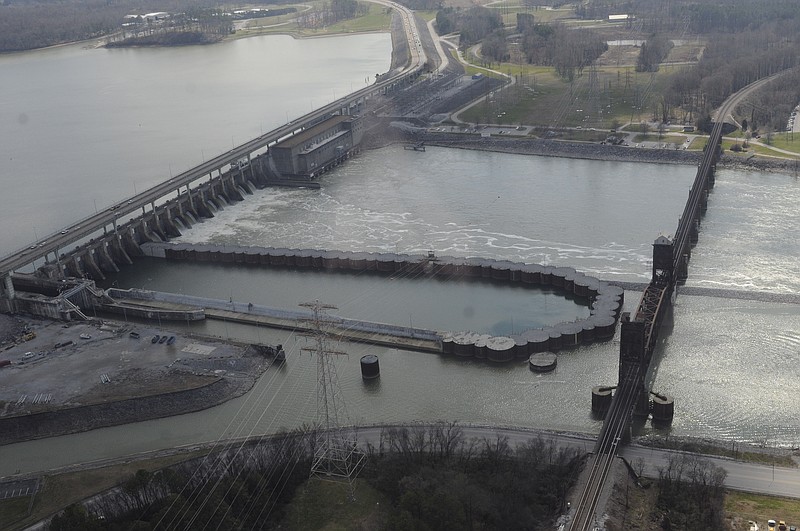Construction work on the new Chickamauga lock is due to get another $37 million next year under a spending plan adopted by a Senate panel Wednesday, ensuring that work on the $858 million project continues for a third consecutive year after construction was previously halted because of a lack of money for inland waterway projects.
The Senate subcommittee on energy and water development appropriations approved a record $6 billion budget Wednesday for the U.S. Army Corps of Engineers, or $1.4 billion more than what the Obama administration had proposed for building civil works projects in the federal budget.
U.S. Sen. Lamar Alexander, R-Tenn., the chairman of the appropriations panel that oversees the Corps of Engineers, said the lock in Chattanooga should continue to receive the fruits of earlier Congressional steps to raise the barge fuel tax rate and to push the Corps to spend all of its available funds.
"The key for Chick Lock is to get on a path of funding that happens year after year," Alexander said. "For awhile there, there was a lot of huffing and puffing and only occasional results."
Working with House appropriators such as U.S. Rep. Chuck Fleischmann, R- Tenn., Alexander said the Congress has helped restore funding for the new and bigger lock at the Chickamauga Dam to replace the 76-year-old existing lock, which is suffering from problems in the concrete aggregate of its walls.
"This will be the third straight year that we have funded the Corps so that there is some funding for Chickamauga lock and having funding year after year after year is a steady path to completion," Alexander said.
In the current fiscal year, the lock is getting $29 million of federal funds.
The Corps proposed building a new lock at the Chickamauga Dam in 2002 but funding ran out a decade later when costly dam and lock projects in Ohio and Pennsylvania absorbed all of the available funding from the Inland Waterways Trust Fund.
The spending bill for water and energy projects next must clear the full Senate Appropriations Committee and could go to the floor of the U.S. Senate as soon as next week to become one of the first appropriation measures adopted by the U.S. Senate.
Alexander also touted the spending package for supporting other major projects in East Tennessee, including a record high budget for science programs that fund the Oak Ridge National Laboratory and $575 million for the Uranium Processing Facility at the Y-12 National Security Complex, which is scheduled for completion in 2025.
The new uranium processing plant has been brought under stricter oversight and spending guidelines to keep its projected cost to $6.5 billion. The facility will still be one of the largest construction projects ever in Tennessee, but the completion costs are now intended to be well below the projected $11 billion price tag put on the project a couple of years ago when design cost overruns threatened to drive costs up far above its original forecast.
Alexander insisted the new uranium processing facility is critical to replace aging World War II-era facilities with more efficient and reliable methods for replenishing America's nuclear arsenal.
'The workers in that facility are working in antiquated conditions and we should be embarrassed to continue that," he said.
Alexander said the redesign of the costlier version of the uranium processing facility in Oak Ridge was improved by a "red team" of experts assembled by Oak Ridge National Laboratory Director Thom Mason, which the senator called "a model for how to deal with huge construction projects."
Overall, the federal budget plan endorsed by Senate members Wednesday would provide nearly $3 billion of funds for Oak Ridge facilities, including ORNL, Y-12 and nuclear cleanup.
But the spending plan cuts funding for a fusion research project in France and limits funding for the Savannah River reprocessing center being built in South Carolina.
Alexander said the DOE is expected to announce a decision next month on U.S. participation in the international thermal nuclear reactor research project in southern France.
"Then we will decide whether we will permanently withdraw from that coalition or proceed in some other way," he said.
Alexander also suggested it could be time to give up on the mixed oxide fuel fabrication facility in South Carolina, even though the project is nearly half finished.
"The cost overrun is so staggering in South Carolina that we have to deal with it and it's unconscionable to me to continue to spend $400 million to $500 million a year when we could do it for far less cost," Alexander said. "Reports from DOE and another red team that Thom Mason assembled suggest that we could dispose of the uranium at half the cost by using a different method than the MOX method."
But Alexander said the federal government should continue its support of nuclear power technology and research into new and better plants.
The budget adopted by Alexander's committee will provide $94.5 million next year for advanced reactors, which is $21 million more than the president's budget request, and $95 million for small modular reactors, which is a $32.5 million increase over last year.
Contact Dave Flessner at dflessner@timesfree press.com or 423-757-6340.
